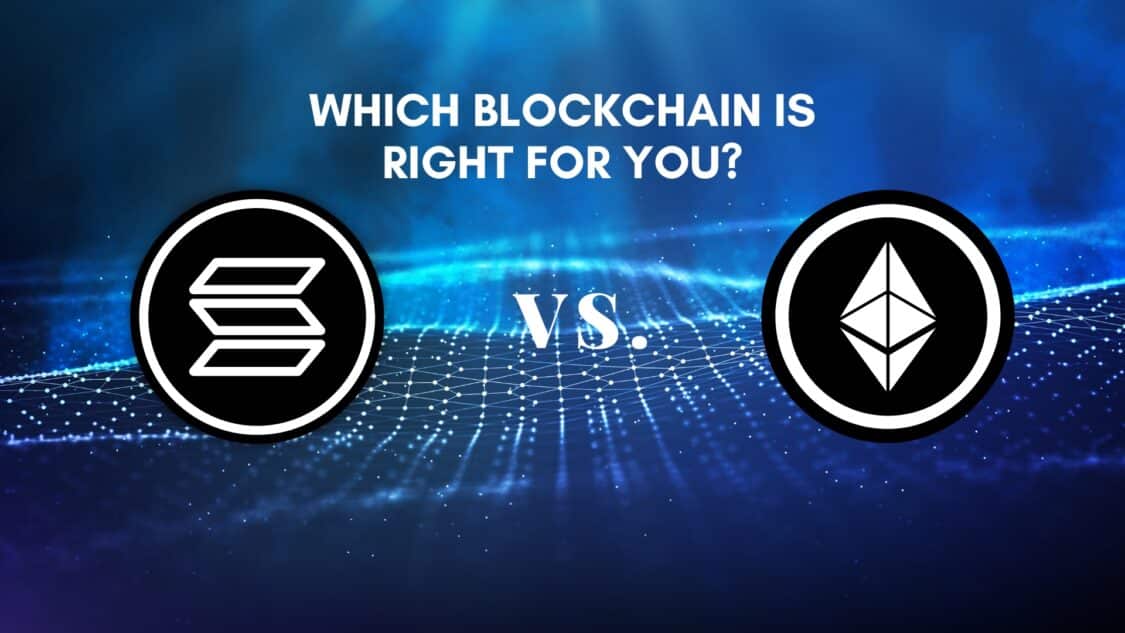- Solana versus Ethereum
- Number of transactions per second:
- Solana versus Ethereum :The cost of a transaction:
- Solana versus Ethereum : Mempool:
- Solana versus Ethereum : Easier Programming:
- Solana versus Ethereum : Solana’s Ecosystem Expansion is Faster:
- Solana versus Ethereum : Solana is Resilient:
- Solana versus Ethereum : Better for the Environment:
Understanding the difference between blockchain networks Solana versus Ethereum can help you make the right decision. Every trader and investor uses the blockchain that best suits their needs. Let’s discuss the difference between the two.

Solana versus Ethereum
Number of transactions per second:
Solana is known for its speed. Therefore, the number of transactions it can perform in a second doesn’t even come close to that of Ethereum. Solana can handle 50,000, while Ethereum has a maximum of 45 per second. However, once Ethereum gets updated to Ethereum 2.0, it will handle 100,000 transactions per second. By implementing a proof-of-stake mechanism and shard chains, Ethereum aims to handle a much larger volume of transactions. This upgrade has the potential to significantly alter the industry landscape by mitigating the transaction speed gap between Solana versus Ethereum, thereby enhancing the latter’s capacity to manage larger transaction volumes with greater efficiency.
While it currently surpasses Ethereum in transaction speed, it’s essential to consider the context and potential future developments. Solana’s exceptional ability to handle many transactions quickly is due to its distinctive consensus mechanism and optimized network structure. This enables it to process transactions at a faster pace.
Solana versus Ethereum :The cost of a transaction:
When comparing Solana versus Ethereum, it is important to consider the significant element of transaction costs, represented by gas fees. Solana’s reduced transaction charges make it an alternative for individuals prioritizing economic operations.
The transactions have a fee called “gas.” This fee is paid to the computer that processes each transaction. The price varies from blockchain to blockchain. Solana is significantly cheaper than Ethereum, standing at $0.00025. Ethereum’s fees, on the other hand, range. They can often be as low as just a few cents or a high of nearly $100. However, as we discussed previously, upgrading Ethereum to Ethereum 2.0 can change this. The gas prices will go nearly zero, making the two competitors.
Solanas’s affordable fees can be advantageous, particularly for users making frequent transactions or those involved in decentralized applications (DApps) that rely on numerous interactions with the blockchain. Ethereum has been trying to solve this issue despite its high transaction fees. Lower gas fees may be possible due to the scalability improvements promised by the Ethereum 2.0 upgrade. This upgrade could help mitigate the cost issues tied to Ethereum transactions and move it towards the price efficiency provided by Solana.

Solana versus Ethereum : Mempool:
A mempool is the waiting area for transactions before they get accepted. On the Ethereum blockchain, transactions in the mempool delay about 4 minutes before verification and acceptance. A mempool doesn’t exist on the Solana blockchain, meaning transactions are accepted instantly. The absence of a mempool in the Solana blockchain presents a significant advantage regarding transaction processing times. Its transactions are accepted instantly, whereas, in the Ethereum blockchain, transactions need to wait in the mempool for verification and acceptance.
This instantaneous transaction acceptance on the network can be attributed to its consensus mechanism and network architecture, which allow for high throughput and rapid transaction confirmation. Eliminating mempool delays provides a seamless and efficient user experience on the network, particularly for applications requiring real-time or rapid transaction processing. This is the number one reason why this asset is an appealing choice for users who value speed and responsiveness in their blockchain transactions.
Solana versus Ethereum : Easier Programming:
A factor that contributes to Solana’s more accessible programming is its use of the Rust programming language. In simple terms, Rust is known for its emphasis on memory safety, performance, and developer productivity. It offers a robust and modern development environment simplifying the process of building applications and smart contracts on the Solana blockchain. The popularity of Rust among developers also adds to the accessibility and resources available for its development. Professionals well-versed in the Rust programming language can utilize their existing knowledge and expertise to design an extensive array of applications, ranging from games to decentralized finance (DeFi) protocols to non-fungible tokens (NFTs) within the Solana ecosystem.
In contrast, Ethereum’s programming language, Solidity, is unique to the Ethereum network. While Solidity offers its set of advantages and a well-established ecosystem, it may have a steeper learning curve for developers new to blockchain programming or who have expertise in other languages. The variety in programming languages might impact the ease of development and the speed at which developers can produce apps on various platforms.
Rust’s accessibility and ease of use as a programming language help to fuel the Solana ecosystem’s exponential growth by attracting a wide variety of developers and facilitating the quick development of new projects and apps on its blockchain.
Solana versus Ethereum : Solana’s Ecosystem Expansion is Faster:

The Ethereum network has quite a few challenges regarding cost and speed. This is because it hosts Dapps on its network along with smart contracts. Solana has not experienced these challenges for the time being. Let’s say that in the future, this issue does arise; they have the potential to support a higher number of coins in comparison to Ethereum. At the present growth rate, Solana’s ecosystem will someday outnumber Ethereum’s in terms of variety and size.
One of the main advantages of the ecosystem of Solana is its scalability and ability to handle a high volume of transactions. Contrary to Ethereum, which has experienced issues with network security and expensive gas prices during intense demand, Solana is built to offer quick and effective transaction processing times. Due to its scalability, it can serve an increasing number of projects, tokens, and decentralized apps (DApps) without affecting the speed or spending excessive money.
Furthermore, due to its promising features and potential, Solana’s ecosystem has gained significant attention and interest from developers, entrepreneurs, and investors. The platform has adopted various projects spanning various industries, including decentralized finance (DeFi), non-fungible tokens (NFTs), gaming, and more. This influx of projects and innovative ideas adds to the rapid expansion of Solana’s ecosystem, creating a vibrant and dynamic environment for developers and users.
With its established scalability, rapid processing capabilities, and attributes for programmers, the Solana blockchain attracts an increasing number of endeavours and individuals to transfer or develop their operations on this platform. The expansion of the Solana ecosystem has placed it in a position to compete with Ethereum, providing a suitable option for decentralized applications and enabling the progression of advanced developments in the realm of blockchain technology.
Solana versus Ethereum : Solana is Resilient:
Mining blocks involve sharing information with computers around the world. This can slow down the process, cause bandwidth problems, and slow down the whole network. Solana divides each block into packets, sends each packet to a group of computers, retransmits the data to the next group, etc. This distributes the load so that it uses less bandwidth, takes less time to process, and results in a more robust network that is less prone to failures.
In addition to its innovative packet-level data distribution approach, it also uses a unique Proof of History (PoH) mechanism that enhances its resilience. PoH timestamps every transaction providing a historical record of all events on the network. This mechanism aids in preventing double-spending and provides a strong chronological order for transactions. This, in turn, ensures the integrity and security of the network. By combining this robust timestamping system with its efficient packet-level data distribution, Sol creates a resilient infrastructure that can uphold future attacks and preserve the consistency and reliability of the network.
Solana versus Ethereum : Better for the Environment:
Ethereum uses a proof-of-work network for mining. PoW uses a lot of power and electricity. On the other hand, Solana uses proof of stake and proof of history, which is more efficient than PoW. Since it uses less power and electricity, it is user-friendly and attracts more users.
The environmental impact of Ethereum’s mining process using the proof-of-work consensus mechanism has caused concern. PoW mining consumes large quantities of energy and results in carbon emissions due to the requirement of specialized mining equipment to solve intricate mathematical problems.
A more energy-efficient option is provided by Solana’s use of the proof-of-stake (PoS) and proof-of-history (PoH) consensus methods. PoS eliminates the need for energy-intensive computations by relying on validators who keep and lock up their tokens as collateral.
Additionally, Solana’s PoH serves as a reliable and efficient timestamping mechanism without the energy-intensive mining process. By adopting these eco-friendly approaches, it reduces its carbon footprint and attracts environmentally conscious users and developers who value this.
Solana versus Ethereum : Is Ethereum more secure than Solana?
Both were designed with a high focus on security. However, they employ different approaches to achieving it. Ethereum, one of the most widely adopted blockchains, has undergone extensive testing and a strong security track record. The engagement of many miners and validators throughout the network presents decentralization and resistance to attacks. Although the likelihood is minimal due to its expansive network, Ethereum’s implementation of a proof-of-work (PoW) consensus system is vulnerable to 51% of attacks.
On the other hand, Solana operates on a combination of proof-of-stake (PoS) and proof-of-history (PoH) mechanisms, which provide enhanced security and efficiency. The PoS mechanism ensures that validators have a stake in the network, whereas the PoH enables efficient timestamping, preventing tampering.
Although Ethereum is considered secure due to its extensive operational history and wide-reaching network, Solana offers a secure platform thanks to its advanced consensus mechanisms and strong design. Although they both have improved their security measures and addressed vulnerabilities, it should be known that no blockchain can completely prevent risks.
In summary, both have put a strong emphasis on security. Ethereum’s established track record and decentralization contribute to its security, while Solana’s combined use of PoS and PoH mechanisms offers innovative security features. Ultimately, the security of any blockchain platform depends on different factors, including network size, consensus mechanism, code audits, and ongoing security practices.




